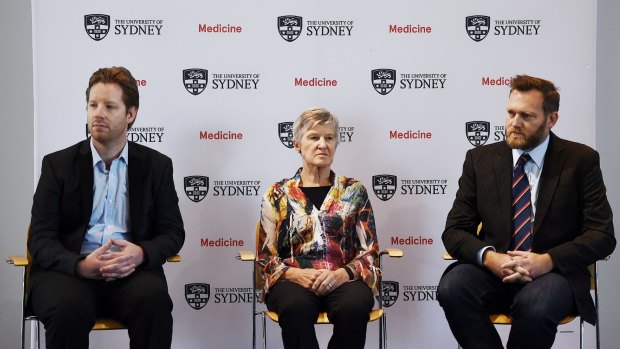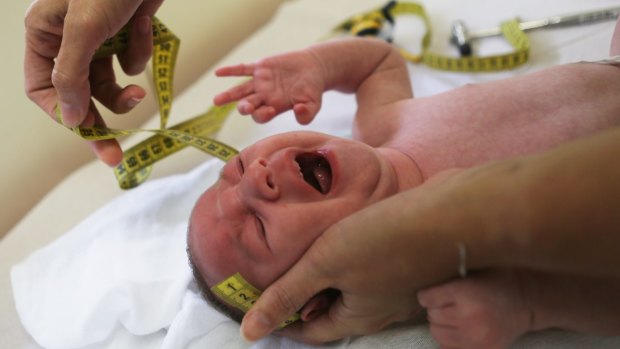This was published 8 years ago
Two confirmed cases of Zika virus in Australia, researchers warn after WHO emergency declaration
By Harriet Alexander and Han Nguyen
The NSW Health department has confirmed two cases of Zika virus in Australia from passengers travelling from the Caribbean back to Sydney.
However the department said the virus did not pose a serious threat to Australia.
"It is very unlikely that Zika virus established local transmission in NSW as the mosquitoes that spread the infection are not established here - although they are found in some parts of north Queensland," Dr Vicky Sheppeard Director of Communicable Diseases said.
The department said the NSW residents had mild cases of the virus and have now recovered.

Dr Grant Hill-Cawthorne (left), Professor Lyn Gilbert and Dr Cameron Webb talk about the Zika virus at Sydney University on Tuesday.Credit: Kate Geraghty
Women who are pregnant, or could be pregnant, are being advised to consider delaying their travel to regions where there is active Zika virus outbreaks, including parts of South and Central America, Mexico, the Caribbean, Samoa and Tonga.
In 2014 there were four cases of Zika virus diagnosed in NSW from people who travelled from Cook Island and one confirmed case in 2015 from a traveller from the Solomon Island.
The department said there were no other cases at this time.
There is "a significant likelihood" that the Zika virus has already been carried into Australia by unsuspecting travellers, but it is unlikely to cause an outbreak outside the tropics, public health researchers say.

A doctor in Brazil measures the head of a two-month-old baby with microcephaly.Credit: Getty Images
Zika has risen from obscurity to international notoriety during its march through the Americas over the past six months because of its possible links to neurological birth defects.
The World Health Organisation declared the mosquito-borne virus an international health emergency on Tuesday, with fears that it could affect up to 4 million people.
Brazil has reported nearly 4000 cases of microcephaly, a neurological condition where the baby is born with a small head and reduced brain function.
The link between Zika and microcephaly has not been proved, but there is strong epidemiological evidence that the virus is responsible.
University of Sydney Professor Lyn Gilbert told a media briefing on Tuesday that the virus had flown under the radar until recently as it caused relatively minor infections in most people, and posed the greatest risk to the unborn children of women in early pregnancy.
"Because 80 per cent of infections are asymptomatic there's quite a significant likelihood of infected people coming back, but unless they happen to travel to far north Queensland, the risk of them being bitten by an appropriate mosquito is relatively small," said Professor Gilbert, who is the clinical lead of Infection Prevention and Control at the Western Sydney Local Health Network.
Zika can only be carried by one type of Australian mosquito - the yellow fever mosquito - and it does not live outside the tropics.
For the disease to spread in Australia, an infected person would need to be bitten by a yellow fever mosquito, which then infected other people.
NSW Health Pathology scientist Cameron Webb said the yellow fever mosquito posed a threat to people because it had migrated out of the jungle and into the cities, but it could not survive in the southern states as the winters were too cold, and even Brisbane was marginal.
If an infected traveller were to return to Townsville or Cairns, local health authorities would activate the same plan that they used to contain in dengue fever outbreaks - using infectious disease officers to decontaminate that person's dwelling.
"You create a doughnut of mosquito control around the infected cases," Dr Webb said.
Pregnant women should avoid travelling to affected countries, Dr Webb said.
But if travel was unavoidable they should take from home mosquito repellent that contained DEET and apply it in the morning, as the mosquitoes that carried Zika bite during the day rather than the evening.
University of Sydney public health researcher Grant Hill-Cawthorne said the WHO's response would galvanise international efforts to develop a vaccine and contain the spread of the disease, but that the declaration of a global health emergency had no practical application on its own.
This is the fourth time that the WHO has invoked such a declaration.
"This is a significant power that the WHO have," Dr Hill-Cawthorne said. "It focuses the world on this outbreak, so it's really a political tool rather than anything else."
Zika was first recognised in Uganda in 1941 and spread across Africa and Asia over the next decade.
There was an outbreak in French Polynesia in 2013, after which it spread into the Americas.
But it did not attract great attention until it reached Brazil, because it is relatively harmless in non-pregnant adults and is asymptomatic in an estimated 80 per cent of the people it infects.
"We often see this with emergent infections, where they've been around a long time and they suddenly explode, and Ebola was a great example of that," Dr Hill-Cawthorne said.
In the case of Zika, this could be because in countries where the disease was established, people were infected as infants and then got lifelong immunity.
"That might be a reason we're suddenly seeing these big explosions in Brazil of adult cases, which we wouldn't normally see in other countries."
Due to patient privacy individual information about the patients was unavailable at the time of writing.